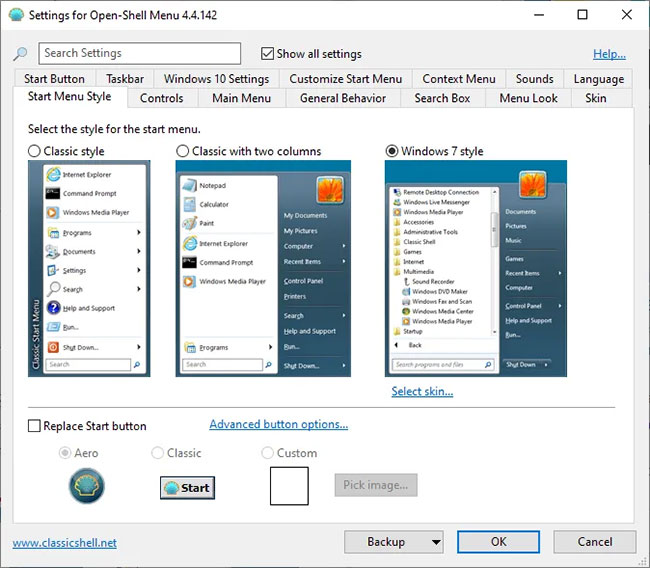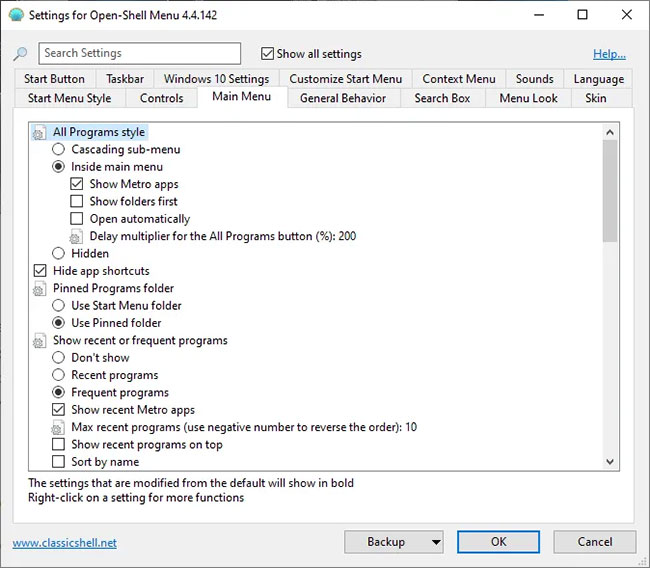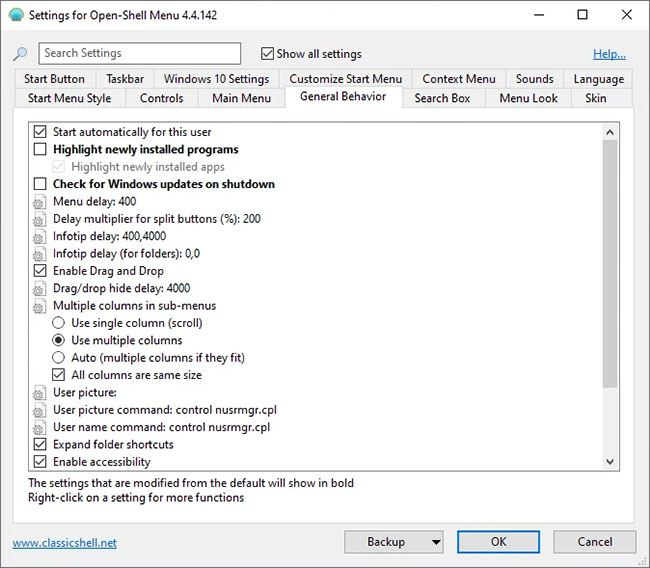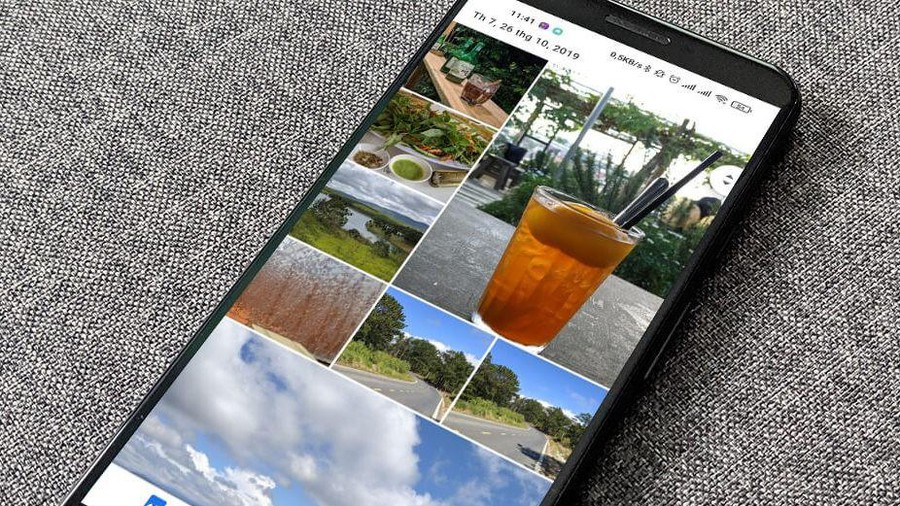How to use Open-Shell to create your own Start menu on Windows 10
Although the look and feel of the Windows Start menu has evolved and changed, its functionality has largely remained the same. For those who love the Start menu in Windows 7, the Windows 10 Start menu may not be very familiar. It's not very customizable and comes with features you might not want, like Cortana, and may even have problems with search.
The best Start menu replacement out there
There are plenty of desktop replacement and customization software out there, but if you're looking to customize your Start menu, then Open-Shell is the app for you. Open-Shell, formerly Classic Shell, ended development in 2017, then picked up and switched to open source Open-Shell.
Classic Shell and Open-Shell have identical functionality and similar interface. The main features of Open-Shell are as follows:
- Classic Start Menu style for Windows 7, 8, 8.1, 10
- Toolbar for Windows Explorer
- Classic user interface (Windows 7 only)
- Displays the file sizes in the Explorer status bar
- Title bar and status bar for Internet Explorer
All of these advertised features are in a powerful freeware that lets you fine-tune almost every part of the Start menu, mix and match Start menu styles, functions, and features across Windows operating system.
How to use Open-Shell
You will first have to download and run the Open-Shell setup, available on GitHub. Just follow the prompts and open the app. Once run, you will be able to easily access Open-Shell's settings by right-clicking on the Start menu icon. Looking at the installs of Open-Shell for the first time can be overwhelming. But you'll only need to focus on a few tabs.

In the ' Start Menu Style ' tab , you can choose your style, look and custom buttons. These are the biggest changes to the Start menu and will completely change the look and feel of the Windows 10 menu. Other tabs allow you to further tweak and customize individual parts of the Start menu.
Style refers to the general format and layout of the Start menu. You can choose between the classic Windows 2000 style, the two-column style reminiscent of Windows 7, and then the actual Windows 7 style. Windows 7 style is the only option in 3 styles with options for interface, of which there are 6 options. If you want to change the Start menu icon to something more vintage or to a custom image, you can also do that from the ' Start Menu Style ' tab .

The other main tabs you'll want to see when setting up your Start menu are the " Main Menu " and " General Behavior " tabs . Under the ' Main Menu ' tab , you will find many screen-related settings that you see when you open the Start menu i.e. the main menu of the Start menu. You can change things like how All Programs, Pinned Programs and Recently Used Programs work in the Start menu, among many more.
Thankfully, the other options of the Open-Shell settings menu are easy to understand, so all the adjustable settings in the ' Main Menu ' tab will be directly related to the main menu and don't overlap much with the other tab.

It's no surprise that the ' General Behavior ' tab contains Start menu settings for general behavior, such as how fast you can switch from one menu to another, how long does it take to get annotations of information, take how long it takes to drag / drop something from the Start menu to somewhere else, etc. For example, if you don't know how much menu lag you want, don't overthink. The default settings aren't too bad, and you can adjust everything if you find something annoying.
Here's the best way to use the other tabs on Open-Shell's settings page. Your daily digital life is evident through the Start menu. If you find yourself starting to frequently access a certain folder or having trouble trying to access a certain shortcut in the Start menu, you won't be forced to get used to it but instead, can open settings. Install Open-Shell, go to the relevant tab and edit the necessary settings.
You should read it
- How to Use the Windows 10 Start Menu
- How to pin any file to Start Menu on Windows 10
- Back up Start Menu settings on Windows 10
- How to bring the traditional Start and Start Menu back on Windows 8?
- How to fix the error can not open the Start Menu on Windows 10
- Invite to admire Start Menu on Windows 10 completely new with modern design and more elegant
- Start Menu does not work and free applications replace
- How to add tile column on Windows Start menu
May be interested
- How to add 'Open PowerShell window here as administrator' to the right-click menu on Windows 10
 windows 10 comes with windows powershell 5.0. windows powershell is a task-based command-line shell and scripting language specifically designed for system administration. this tutorial will show you how to add or remove 'open powershell window here as administrator' on windows 10 right-click menu.
windows 10 comes with windows powershell 5.0. windows powershell is a task-based command-line shell and scripting language specifically designed for system administration. this tutorial will show you how to add or remove 'open powershell window here as administrator' on windows 10 right-click menu. - Trick to Run commands on Start Menu and Taskbar on Windows 10
 on windows 10 you usually open the run command by typing the keyword run in the search box and then press enter, or right-click the start button and select run from the options menu, or alternatively press the windows + r. key combination. you may not know on windows 10, users can pin the run command to start menu for faster access.
on windows 10 you usually open the run command by typing the keyword run in the search box and then press enter, or right-click the start button and select run from the options menu, or alternatively press the windows + r. key combination. you may not know on windows 10, users can pin the run command to start menu for faster access. - Back up Start Menu settings on Windows 10
 start menu on windows 10 is one of the useful and customizable tools. you can arrange a new layout on the left to access settings and other locations. in the middle you can quickly access the list of applications you have installed and on the right side you can set live tiles to continuously display updates.
start menu on windows 10 is one of the useful and customizable tools. you can arrange a new layout on the left to access settings and other locations. in the middle you can quickly access the list of applications you have installed and on the right side you can set live tiles to continuously display updates. - Invite to admire Start Menu on Windows 10 completely new with modern design and more elegant
 recently, cage ata, a designer has shared the image of the idea of start menu with remarkable changes, creating good visual effects and creating a fresh feeling that many people can enjoy.
recently, cage ata, a designer has shared the image of the idea of start menu with remarkable changes, creating good visual effects and creating a fresh feeling that many people can enjoy. - Some ways to fix Start Menu error on Windows 10 stops working
 start menu is probably the most popular feature of windows 10. however, for some pc versions, this feature may be broken. in this article, tipsmake.com will guide you how to fix start menu errors on windows 10.
start menu is probably the most popular feature of windows 10. however, for some pc versions, this feature may be broken. in this article, tipsmake.com will guide you how to fix start menu errors on windows 10. - Reveal the first image of the improved Start Menu, remove Live Tiles on Windows 10
 what microsoft is testing with the start menu has been leaked due to an incident that caused the windows insider program to accidentally send a version of windows 10 build 18947, which is used in the xbox development team to test users.
what microsoft is testing with the start menu has been leaked due to an incident that caused the windows insider program to accidentally send a version of windows 10 build 18947, which is used in the xbox development team to test users. - 5 ways to open applications in Windows 10
 opening an application on windows 10 is easy if you have pinned the application to the start menu. if not, there is always an apps list - the list of applications in the start menu will allow you to launch most of your applications.
opening an application on windows 10 is easy if you have pinned the application to the start menu. if not, there is always an apps list - the list of applications in the start menu will allow you to launch most of your applications. - How to add tile column on Windows Start menu
 by default, windows 10 displays three tile columns in the start menu. it has a hidden fourth column that users don't know.
by default, windows 10 displays three tile columns in the start menu. it has a hidden fourth column that users don't know. - Instructions to pin web pages to Start Menu in Windows 10
 recently, tipsmake.com has guided you to read how to pin the website to the windows 10 taskbar in the article: browser tips useful on windows 10 fall creators update, if you want to pin your favorite website to the start menu don't miss the article below!
recently, tipsmake.com has guided you to read how to pin the website to the windows 10 taskbar in the article: browser tips useful on windows 10 fall creators update, if you want to pin your favorite website to the start menu don't miss the article below! - Start Menu does not work and free applications replace
 here are 6 great apps and useful shortcuts you can use when windows 10 start menu fails.
here are 6 great apps and useful shortcuts you can use when windows 10 start menu fails.










 How to download Google Drive to your computer and phone is simple and fast
How to download Google Drive to your computer and phone is simple and fast How to design profile photos on Profile Pic Maker for free
How to design profile photos on Profile Pic Maker for free What is Malwarebytes? How to use Malwarebytes remove malware
What is Malwarebytes? How to use Malwarebytes remove malware How to use the new editing tools on Google Photos
How to use the new editing tools on Google Photos Review MiniTool Partition Wizard Free v11.5
Review MiniTool Partition Wizard Free v11.5 TOP 20 software to recover deleted data on hard drives, USB, memory cards
TOP 20 software to recover deleted data on hard drives, USB, memory cards